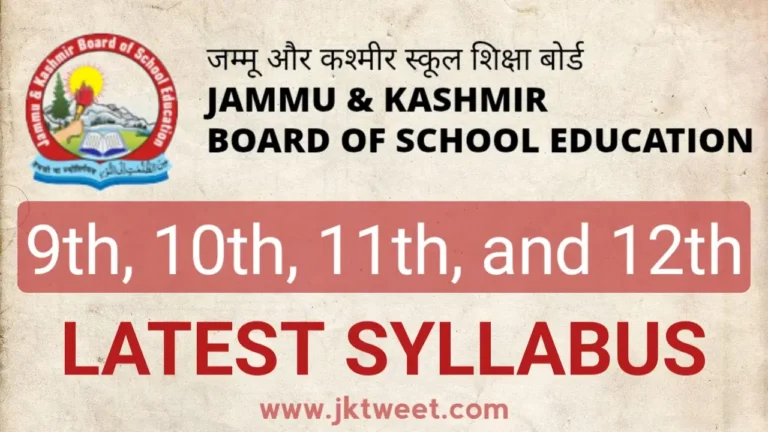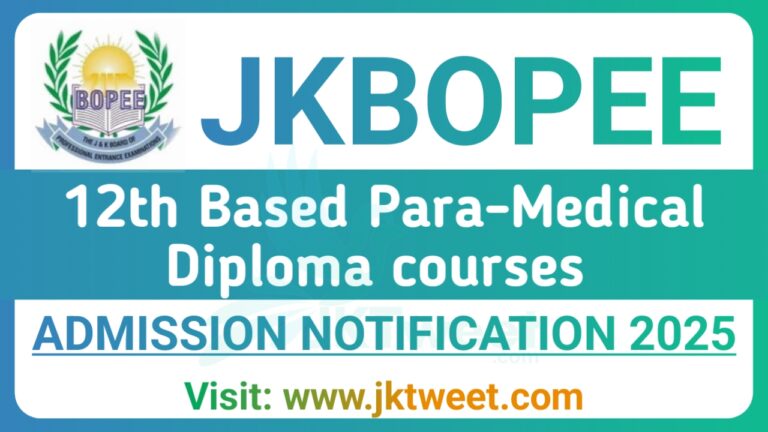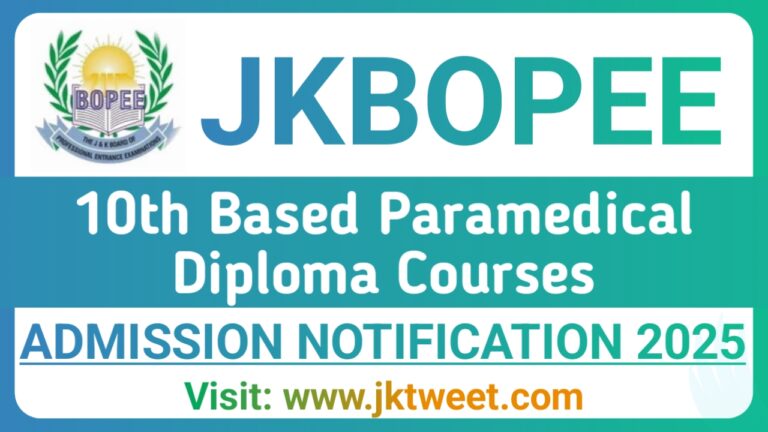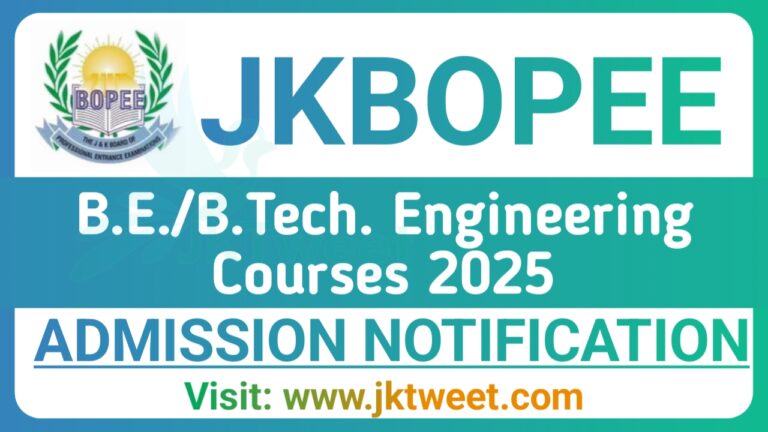The Jammu and Kashmir Board of Professional Entrance Examination (JKBOPEE) has released the revised Syllabus for Common Entrance Test of B.Sc. Nursing/B.Sc. Paramedical/B.Sc. Technology Courses-2024.
The J&K BOPEE has received few representations from the candidates regarding the syllabus mentioned in the e-Information Brochure for Common Entrance Test of B.Sc. Nursing/B.Sc.Paramedical/ B.Sc. Technology Courses 2024.
The Board after examining the said representations decided to upload the revised syllabus for the said examination and is accordingly annexed as Annexure A to this Notice.
Hence the students are accordingly advised to prepare Common Entrance Test strictly as per the syllabus Annexed to this Notice & Syllabus mentioned in the e-information of B.Sc. Nursing/B.Sc. Paramedical/B.Sc. Tech.-2024 shall be deemed to be deleted.
JKBOPEE B.Sc. Nursing/Paramedical/Technology Syllabus 2024
1. Physics: (Total marks: 60)
UNIT 1: PHYSICAL WORLD AND MEASUREMENT (Marks: 02)
Need for measurement: Units of measurement; systems of units; SI units, fundamental and derived units. Significant figures. Dimensions of physical quantities, dimensional analysis and its applications.
UNIT 2: KINEMATICS (Marks: 03)
Motion in a Straight Line
Frame of reference, Motion in a straight line, Elementary concepts of differentiation and integration for describing motion, uniform and non-uniform motion, and instantaneous velocity, uniformly accelerated motion, velocity – time and position-time graphs. Relations for uniformly accelerated motion (graphical treatment).
Motion in a Plane
Scalar and vector quantities; position and displacement vectors, general vectors and their notations; equality of vectors, multiplication of vectors by a real number; addition and subtraction of vectors, Unit
vector; resolution of a vector in a plane, rectangular components, Scalar and Vector product of vectors.
Motion in a plane, cases of uniform velocity and uniform acceleration projectile motion, uniform circular motion.
UNIT 3: LAWS OF MOTION (Marks: 02)
Laws of Motion Intuitive concept of force, Inertia, Newton’s first law of motion; momentum and Newton’s second law of motion; impulse; Newton’s third law of motion. Law of conservation of linear
momentum and its applications. Equilibrium of concurrent forces, Static and kinetic friction, laws of friction, rolling friction, lubrication. Dynamics of uniform circular motion: Centripetal force, examples of
circular motion (vehicle on a level circular road, vehicle on a banked road).
UNIT 4: WORK, ENERGY AND POWER (Marks: 02)
Work, Energy and Power
Work done by a constant force and a variable force; kinetic energy, work energy theorem, power. Notion of potential energy, potential energy of a spring, conservative forces: non-conservative forces, motion in a vertical circle; elastic and inelastic collisions in one and two dimensions.
UNIT 5: MOTION OF SYSTEM OF PARTICLES AND RIGID BODY (Marks: 02)
System of Particles and Rotational Motion Centre of mass of a two-particle system, momentum conservation and Centre of mass motion. Centre of mass of a rigid body; centre of mass of a uniform rod. Moment of a force, torque, angular momentum, law of conservation of angular momentum and its applications. Equilibrium of rigid bodies,
rigid body rotation and equations of rotational motion, comparison of linear and rotational motions. Moment of inertia, radius of gyration, values of moments of inertia for simple geometrical objects (noderivation).
UNIT 6: GRAVITATION (Marks: 02)
Kepler’s laws of planetary motion, universal law of gravitation. Acceleration due to gravity and its variation with altitude and depth. Gravitational potential energy and gravitational potential, escape speed, orbital velocity of a satellite.
UNIT 7: PROPERTIES OF BULK MATTER (Marks: 02)
Mechanical Properties of Solids
Elasticity, Stress-strain relationship, Hooke’s law, Young’s modulus, bulk modulus, shear modulus of rigidity (qualitative idea only), Poisson’s ratio; elastic energy.
Mechanical Properties of Fluids
Pressure due to a fluid column; Pascal’s law and its applications (hydraulic lift and hydraulic brakes), effect of gravity on fluid pressure. Viscosity, Stokes’ law, terminal velocity, streamline and turbulent flow, critical velocity, Bernoulli’s theorem and its simple applications. Surface energy and surface tension, angle of contact, excess of pressure across a curved surface, application of surface tension ideas
to drops, bubbles and capillary rise.
Thermal Properties of Matter
Heat, temperature, thermal expansion; thermal expansion of solids, liquids and gases, anomalous expansion of water; specific heat capacity; Cp, Cv – calorimetry; change of state – latent heat capacity.
Heat transfer-conduction, convection and radiation, thermal conductivity, qualitative ideas of Blackbody radiation, Wein’s displacement Law, Stefan’s law.
UNIT 8: THERMODYNAMICS (Marks: 03)
Thermal equilibrium and definition of temperature, zeroth law of thermodynamics, heat, work and internal energy. First law of thermodynamics, Second law of thermodynamics: gaseous state of matter,
change of condition of gaseous state -isothermal, adiabatic, reversible, irreversible, and cyclic processes.
UNIT 9: BEHAVIOUR OF PERFECT GAS AND KINETIC THEORY (Marks: 02)
Kinetic Theory Equation of state of a perfect gas, work done in compressing a gas. Kinetic theory of gases – assumptions, concept of pressure, Expression for pressure exerted by a gas. Kinetic interpretation of temperature; rms speed of gas molecules; degrees of freedom, law of equipartition of energy. (statement only) and application to specific heat capacities of gases; concept of mean free path, Avogadro’s number.
UNIT 10: OSCILLATIONS AND WAVES (Marks: 04)
Oscillations Periodic motion – time period, frequency, displacement as a function of time, periodic functions and their applications. Simple harmonic motion (S.H.M) and its equations of motion; phase; oscillations of a loaded spring- restoring force and force constant; energy in S.H.M. Kinetic and potential energies; simple pendulum derivation of expression for its time period.
Waves
Wave motion: Transverse and longitudinal waves, speed of travelling wave, displacement relation for a progressive wave, principle of superposition of waves, reflection of waves, standing waves in strings and organ pipes, fundamental mode and harmonics, Beats.
UNIT 11: ELECTROSTATICS (Marks: 04)
Electric Charges and Fields
Electric charges, Conservation of charge, Coulomb’s law-force between two- point charges, forces between multiple charges; superposition principle and continuous charge distribution. Electric field, electric field due to a point charge, electric field lines, electric dipole, electric field due to a dipole,
torque on a dipole in uniform electric field. Electric flux, statement of Gauss’s theorem and its applications to find field due to infinitely long straight wire, uniformly charged infinite plane sheet and
uniformly charged thin spherical shell (field inside and outside).
Electrostatic Potential and Capacitance
Electric potential, potential difference, electric potential due to a point charge, a dipole and system of charges; equipotential surfaces, electrical potential energy of a system of two-point charges and of electric dipole in an electrostatic field. Conductors and insulators, free charges and bound
charges inside a conductor. Dielectrics and electric polarization, capacitors and capacitance, combination of capacitors in series and in parallel, capacitance of a parallel plate capacitor with and
without dielectric medium between the plates, energy stored in a capacitor (no derivation, formulae only).
UNIT 12: CURRENT ELECTRICITY (Marks: 04)
Electric current, flow of electric charges in a metallic conductor, drift velocity, mobility and their relation with electric current; Ohm’s law, V-I characteristics (linear and non-linear), electrical energy and power, electrical resistivity and conductivity, temperature dependence of resistance, Internal resistance of a cell, potential difference and emf of a cell, Kirchhoff’s rules, Wheatstone bridge.
UNIT 13: MAGNETIC EFFECTS OF CURRENT AND MAGNETISM (Marks: 05)
Moving Charges and Magnetism Concept of magnetic field, Concept of magnetic field, Oersted’s experiment. Biot – Savart law and its application to current carrying
circular loop. Ampere’s law and its applications to infinitely long straight wire. Straight solenoid (only qualitative treatment), force on a moving charge in uniform magnetic and electric fields. Force on a current-carrying conductor in a uniform magnetic field, force between two parallel current-carrying conductors-definition of ampere, torque experienced by a current loop in uniform magnetic field;
Current loop as a magnetic dipole and its magnetic dipole moment, moving coil galvanometer- its current sensitivity and conversion to ammeter and voltmeter.
Magnetism and Matter
Bar magnet, bar magnet as an equivalent solenoid (qualitative treatment only), magnetic field intensity due to a magnetic dipole (bar magnet) along its axis and perpendicular to its axis (qualitative treatment only), torque on a magnetic dipole (bar magnet) in a uniform magnetic field (qualitative treatment only), magnetic field lines. Magnetic properties of materials- Para-, dia- and ferro – magnetic substances with examples, Magnetization of materials, effect of temperature on magnetic properties.
UNIT 14: ELECTROMAGNETIC INDUCTION AND ALTERNATING CURRENTS (Marks: 04)
Electromagnetic Induction
Electromagnetic induction; Faraday’s laws, induced EMF and current; Lenz’s Law, Self and mutual induction.
Alternating Current
Alternating currents, peak and RMS value of alternating current/voltage; reactance and impedance; LCR series circuit (phasors only), resonance, power in AC circuits, power factor, wattles current. AC generator, Transformer.
UNIT 15: ELECTROMAGNETIC WAVES (Marks: 03)
Basic idea of displacement current, Electromagnetic waves, their characteristics, their transverse nature (qualitative idea only). Electromagnetic spectrum (radio waves, microwaves, infrared, visible, ultraviolet,
X-rays, gamma rays) including elementary facts about their uses.
UNIT 16: OPTICS (Marks: 07)
Ray Optics and Optical Instruments
Ray Optics: Reflection of light, spherical mirrors, mirror formula, refraction of light, total internal reflection and optical fibers, refraction at spherical surfaces, lenses, thin lens formula, lens maker’s formula, magnification, power of a lens, combination of thin lenses in contact, refraction of light through a prism. Optical instruments: Microscopes and astronomical telescopes (reflecting and refracting) and their magnifying powers.
Wave Optics Wave optics: Wave front and Huygen’s principle, reflection and refraction of plane wave at a plane surface using wave fronts. Proof of laws of reflection and refraction using Huygen’s principle.
Interference, Young’s double slit experiment and expression for fringe width (No derivation final expression only), coherent sources and sustained interference of light, diffraction due to a single slit, width of central maxima (qualitative treatment only).
UNIT 17: DUAL NATURE OF MATTER AND RADIATION (Marks: 02)
Dual nature of radiation, Photoelectric effect, Hertz and Lenard’s observations; Einstein’s photoelectric equation-particle nature of light. Experimental study of photoelectric effect Matter waves-wave nature
of particles, de-Broglie relation.
UNIT 18: ATOMS AND NUCLEI (Marks: 03)
Atoms Alpha-particle scattering experiment; Rutherford’s model of atom; Bohr model of hydrogen atom, Expression for radius of nth possible orbit, velocity and energy of electron in nth orbit, hydrogen line spectra (qualitative treatment only).
Nuclei Composition and size of nucleus, nuclear force Mass-energy relation, mass defect; binding energy per nucleon and its variation with mass number; nuclear fission, nuclear fusion.
UNIT 19: ELECTRONIC DEVICES (Marks: 04)
Semiconductor Electronics
Materials, Devices and Simple Circuits Energy bands in conductors, semiconductors and insulators (qualitative ideas only) Intrinsic and extrinsic semiconductors- p and n type, p-n junction Semiconductor diode – I-V characteristics in forward and reverse bias, application of junction diode -diode as a rectifier.
Chemistry (Total Marks: 60)
UNIT 1: Basic Concepts of Chemistry & ATOMIC STRUCTURE (Marks: 04)
Laws of Chemical combination (numerical), Dalton’s Atomic Theory, Concept of elements, atoms & molecules. Atomic and molecular masses, Mole concept and molar mass, percentage composition, empirical and molecular formula; chemical reactions, stoichiometry and calculation based on stoichiometry.
Structure of Atom: Discovery of electron, proton and neutron, atomic number, isotopes and isobars. Thompson’s model and its limitations, Rutherford’s model and its limitations. Bohr’s model & its limitations, concept of shells and sub-shells. Dual nature of matter and light, de-Broglie’s relationship.
Heisenberg’s uncertainty principle, concept of orbitals, quantum numbers, shapes of s, p and d- orbitals. Rules for filling electrons in orbitals- Aufbau’s principle, Pauli’s exclusion principle and Hund’s rule. Electronic configuration of atoms, stability of half-filled and completely filled orbitals.
UNIT 2: CHEMICAL EQUILIBRIUM (Marks: 04)
Equilibrium in physical and chemical processes, dynamic nature of equilibrium, law of mass action, equilibrium constant, factors affecting equilibrium: Le-Chatelier’s principle equilibrium-ionization of acids and bases, strong and weak electrolytes, degree of ionization, Concept of pH. Hydrolysis of salts (elementary idea), buffer solutions. Solubility product, common ion effect (with suitable examples).
UNIT 3: CHEMICAL KINETICS (Marks: 02)
Rate of reaction (average and instantaneous rate of a reaction), factors affecting rate of reactions: (concentration, temperature, catalyst), rate law, specific rate constant and order, molecularity of a reaction, integrated rate expression of zero and first order reactions and their derivations, half-life period. Concept of collision theory (elementary idea, no mathematical derivation). Activation energy,
Arrhenius equation.
UNIT 4: SOLUTIONS (Marks: 02)
Types of solutions, expression of concentration of solutions of solids in liquids, solubility of gases in liquids, solid solutions, colligative properties: relative lowering of vapor pressure of a solution, Raoult’s law, elevation of boiling point, depression in freezing point temperature and osmotic pressure), determination of molecular masses using colligative properties. Abnormal molecular mass, Van’t Hoff
factor and calculations involving it.
UNIT 5: CHEMICAL THERMODYNAMICS (Marks: 04)
Concepts of system, types of systems, surrounding, work, heat; energy intensive and extensive properties, state functions. First Law of Thermodynamics, internal energy, enthalpy, heat capacity, specific heat, molar heat capacity, measurement of E and H, Hess’s law of constant heat summation, enthalpy of bond dissociation, combustion; formation, atomization, sublimation, phase transition ionization and dilution. Introduction of entropy as a state function, free energy change for spontaneous
and non-spontaneous process and equilibrium.
UNIT 6: REDOX REACTIONS AND ELECTROCHEMISTRY (Marks: 03)
Concept of oxidation and reduction, redox reactions, oxidation number, balancing of chemical equations in redox reactions, applications of redox reactions, conductance in electrolytic solutions, specific conductivity, molar conductivity, variation of conductivity with concentration, Kohlrausch’s law and its applications Electrolysis and laws of electrolysis (elementary idea), dry cell-electrolytic cells and galvanic
cells; Lead accumulator, emf of a cell, standard electrode potential, Nernst equation and its application to Chemical cells, relation between Gibb’s energy change and emf of a cell, fuel cells, corrosion
UNIT 7: PERIODIC PROPERTIES (Marks: 02)
Significance of classification, brief history of the development of periodic table. Modern periodic law and the present form of the periodic table, periodic trends in properties of elements: atomic radii, ionic radii, inert gas radii, ionization enthalpy, electron gain enthalpy, electronegativity, valency.
UNIT 8: CHEMICAL BONDING AND MOLECULAR STRUCTURE (Marks: 04)
Valence electrons, lonic bond, covalent bond, bond parameters, Lewis structure, polar character of covalent bond, valence bond theory, resonance, geometry of covalent molecules, VSEPR theory, concept of hybridization involving s, p and d-orbitals and shapes of some simple molecules, molecular orbital theory of homonuclear molecules (Qualitative idea only), hydrogen bond.
UNIT 9: CO-ORDINATION CHEMISTRY (Marks: 04). Co-ordination compounds: Introduction, ligands, co-ordination number, color, magnetic properties and shapes, IUPAC nomenclature of mononuclear co-ordination compounds. Bonding (Werner’s theory, VBT and CFT), structural and stereoisomerisms, importance of coordination compounds in qualitative
inclusion of analysis, extraction of metals and biological systems.
UNIT 10: ORGANIC CHEMISTRY-SOME BASIC PRINCIPLES AND TECHNIQUES (Marks: 04)
General introduction to organic chemistry, methods of purification, qualitative and quantitative analysis, classification and IUPAC nomenclature of organic compounds.
Electronic displacement in a covalent bond: inductive effect, electromeric effect, resonance and hyper- conjugation. Homolytic and heterolytic fission of a covalent bond, free radicals, electrophiles,
nucleophiles, carbocations and carbanions. Types of organic reactions.
UNIT 11: d and f-BLOCK ELEMENTS (Marks: 04)
General introduction, electronic configuration, occurrence and characteristics of the transition meals, general trends in properties of first row transition metals (metallic character, IE, electrode potential, oxidation state, ionic radii, catalytic properties, colored ions, complex formation, magnetic properties,
interstitial compounds, alloy formation). Preparation and properties of K2Cr2O7 and KMnO4 Lanthanides: electronic configuration, oxidation state, chemical reactivity and lanthanide contraction and its consequences. Actinides- electronic configuration, oxidation states and comparison with lanthanoids.
UNIT 12: HYDROCARBONS (Marks: 04)
Classification of hydrocarbons Alkanes: Nomenclature, isomerism, conformations (ethane only), physical properties. Chemical reactions including free radical mechanism of halogenation, combustion and Pyrolysis
Alkenes: Nomenclature, structure of double bond (ethene), geometrical isomerism, methods of preparation, physical properties, chemical reactions- addition of hydrogen. halogen, water, hydrogen halides (Markownikov’s addition and peroxide effect). ozonolysis, oxidation, mechanism of electrophilic addition.
Alkynes: Nomenclature, structure of triple bond (ethyne), physical properties, methods of preparation, chemical reactions: acidic character of alkynes, addition reaction of hydrogen, halogens, hydrogen halides and water, Aromatic hydrocarbons introduction, IUPAC nomenclature, Benzene resonance,
aromaticity, chemical properties, mechanism of electrophilic substitution-nitration, sulphonation, halogenations Friedel Craft’s alkylation and acylation, directive influence of functional group in mono substituted benzene.
UNIT 13: HALOALKANES AND HALOARENES (Marks: 04)
Haloalkanes: Nomenclature, nature of C-X bond, physical & chemical properties, mechanism of substitution reactions. Stability of carbocations, R-S and d-1 configurations
Haloarenes: Nature of C-X bond, substitution reactions (directive influence of halogens for mono substituted compounds only), Stability of carbocations, R-S and D-L configurations Uses and environmental effects of-dichloromethane, trichloromethane, tetrachloromethane, iodoform, freon,
and DDT
UNIT 14: ALCOHOLS, PHENOLS AND ETHERS (Marks: 04)
Alcohols: Nomenclature, methods of preparation, physical & chemical properties (of primary alcohols only), identification of primary, secondary & tertiary alcohols; mechanism of dehydration of alcohols.
Uses, some important compounds – methanol and ethanol.
Phenols: Nomenclature, methods of preparation, physical & chemical properties, acidic nature of phenol, electrophillic substitution reactions, uses of phenols.
Ethers: Nomenclature, methods of preparation, physical & chemical properties and uses.
UNIT 15: ALDEHYDES, KETONES AND CARBOXYLIC ACIDS (Marks: 04)
Aldehydes and Ketones: Nomenclature, nature of carbonyl group, methods of preparation, physical & chemical properties & mechanism of nucleophilic addition reaction to C=O group, reactivity of alpha hydrogen in aldehydes, uses
Carboxylic Acids: Nomenclature, acidic nature, methods of preparation, physical & chemical properties and uses
UNIT 16: ORGANIC COMPOUNDS CONTAINING NITROGEN (Marks: 03)
Amines: Nomenclature, classification, structure, methods of preparation, physical & chemical properties, uses, identification of primary, secondary & tertiary amines Cyanides and Isocyanides: Structures of cyanide and isocyanide groups, nomenclature, preparation, physical properties and chemical reactions
Diazonium Salts: Preparation and chemical reactions (mechanism of diazotization), and importance aesthetic organic chemistry
UNIT 17: MOLECULES OF LIFE (Marks: 04)
Carbohydrates: Classification (aldoses and ketoses), mono saccharides: Glucose, fructose: structure, preparation and chemical reactions, oligosaccharidees (sucrose, lactose & maltose) Polysaccharides: (starch cellulose and glycogen); importance.
Proteins: Elementary idea of amino acids: peptide bond, polypeptides and primary, secondary, etary and qualemary structure of proteins (Qualitative idea only), denaturation of proteins; enzymes, lips & harmones, their classification & functions. Nucleic Acids: DNA and RNA (purines and pyrimidines, nucleosides, nucleotides and fragments up to four nucleotides).
Vitamins: Classification and functions, sources and deficiency diseases.
Nucleic Acids: DNA and RNA (purines and pyrimidines, nucleosides, nucleotides and fragments up to four nucleotides).
Vitamins: Classification and functions, sources and deficiency diseases.
Biology (Total Marks: 60)
Unit I: Diversity of Life (Marks: 04)
Biodiversity:
Variety of living organisms; Need and History of classification – Artificial, Natural and Phylogenetic classifications.
Biosystematics: Taxonomy and Systematics; Concept of species and Taxonomical hierarchy; Binomial nomenclature; Herbarium.
Two Kingdom and Five kingdom classifications and their merits and demerits; General characters and classification of Monera, Protista and Fungi; Lichens; Status of Viruses, and Viroids.
Unit II: Kingdom Plantae (Marks: 03)
Classification of plants into major groups; General characters of Algae, Bryophyta, Pteridophyta and Gymnosperms and their classes.
Morphology of Flowering plants and their function: Morphology of root, stem and leaf (without their modifications); Morphology of Inflorescence, flower, fruit and seed. Description of family Solanaceae.
Unit III: Plant Anatomy (Marks: 03)
Tissue systems in plants – Epidermal, ground and vascular tissue systems; Anatomy and functions of dicot and monocot root, stem and leaves.
Unit IV: Plant Physiology (Marks: 04)
Respiration: Cellular respiration; Glycolysis, Kreb’s cycle and Electron transport system (along with ATP energetics); Chemiosmotic hypothesis; Aerobic and Anaerobic respirations; Amphibolic pathways;
Respiratory quotient.
Photosynthesis: Historical background; Site of Photosynthesis; Photosynthetic pigments; Mechanism of Photosynthesis – Light dependent phase (Light reaction), Photosystems; Cyclic and non-cyclic photo
phosphorylations; Light independent (biosynthetic) phase – Calvin (C3) cycle and Hatch & Slack (C4) cycle; Factors affecting photosynthesis; Photorespiration. Plant Growth and Development:
Characteristics of plant growth; phases of growth, growth rate, growth curve; conditions of growth;
differentiation, dedifferentiation and redifferentiation. Sequence of developmental process in a plant cell; Plant growth regulators; Discovery and physiological effects of Auxins, Gibberellins, Cytokinins,
Ethylene and Abscissic Acid.
UNIT V: Diversity in Living World (Marks: 03)
Animal Kingdom; General characters and classification of animals (non-chordates up to phyla level and chordates up to the level of class).
National Parks with special reference to Dachigam, Kishtwar, Salim Ali, Kazinag and Hemis. Concept of Sanctuaries and Biosphere reserves.
Unit VI: Structural Organisation and Animal Biomolecules (Marks: 03)
Morphology, Anatomy and functions of digestive, circulatory, respiratory, nervous and reproductive systems of Frog.
Basic chemical constituents of living bodies; Bio-molecules: Structure and function of Carbohydrates, proteins, lipids and Nucleic acids; Primary and secondary metabolites. Enzymes: Types, Properties and functions
Unit VII: Cell Structure and Function (Marks: 04) Cell: Brief description of cell; Cell theory; Prokaryotic and Eukaryotic cell, Cell wall, Membrane and Cell organelles (Plastids, Mitochondria, E.R., Golgi, Ribosomes, Lysosomes, Nucleus, Vacuoles, centrioles and Cytoskeleton); Cilia and Flagella; Nuclear organisation. Cell Division: Cell Cycle, Mitosis and Meiosis.
Unit VIII: Human Physiology (Marks: 04)
Breathing and Respiration: Respiratory system in humans; mechanism of breathing and its regulation in humans; respiratory volume; Exchange of gases and their transport; Respiratory disorders.
Body fluids and Circulation: Composition of blood; Blood groups and Rh factor; Lymph; Human
Circulatory system; Cardiac cycle and ECG; Double circulation; regulation of cardiac activity; Disorders of circulatory system.
Excretory Products and their Elimination: Modes of excretion; Human excretory system; Urine formation, osmo regulation; regulation of kidney function; Urinary disorders; and artificial kidney.
Locomotion and Movement: Types of movement; Muscle, Contractile proteins and Muscle contraction (Mechanism); Skeletal system and its functions; Joints; Disorders of muscular and skeletal systems.
Neural Control and Coordination: Neuron and nerves; Nervous system in humans; Nerve impulse.
Chemical Coordination and Integration: Human endocrine system; Hormones of Heart, Kidney and G.I. Tract; Mechanism of hormone action (elementary idea); Hormonal disorders.
(Note: diseases of human physiology systems to be taught in brief)
Unit IX: Reproduction in Flowering Plants (Marks: 04) Sexual Reproduction: Flower structure; Development of male and female gametophytes; Pollination – types, agencies and examples; Out breeding devices; Pollen-Pistil interactions; Double fertilization; Post fertilization events – Development of Endosperm, embryo; Development of seed and formation of fruit; special modes – apomixis, parthenocarpy, polyembryony; Significance of seed and fruit formation.
Unit X: Genetics (Marks: 04)
Heredity and variation Mendelian inheritance; deviations from Mendelism: Incomplete Dominance; Co- dominance; Multiple alleles and inheritance of blood groups; Pleiotropy; Elementary idea of polygenic inheritance; Chromosomal theory of Inheritance; Chromosomes and genes.
Molecular Basis of Inheritance: Search for genetic material and DNA as genetic material; Structure of DNA and RNA; DNA packaging; DNA replication; Central Dogma; Protein Biosynthesis: Transcription,
genetic code, translation; Gene expression and regulation – lac Operon.
Unit XI: Biology and Human Welfare (Marks: 04)
Tissue Culture: Cellular totipotency, technique and application of tissue culture.
Microbes in Human welfare: Microbes in food processing, industrial production, sewage treatment, energy generation (Biogas) and microbes as bio-control agents, Biopesticides and Bio-fertilizers.
Antibiotics; production and judicious use.
Application of Biotechnology in Agriculture: Genetically Modified organisms – BT crops; Biopiracy and patents.
Unit XII: Ecology and Environment (Marks: 03)
Populations: Population attributes and Population growth; Population interactions -mutualism, competition, predation, parasitism; population attributes – growth, birth rate and death rate, age distribution.
Ecosystems: Patterns, components; productivity and decomposition; energy flow; Ecological pyramids:
Pyramids of number, biomass and energy.
Biodiversity and its Conservation: Biodiversity-Concept, patterns, importance; loss of biodiversity; biodiversity conservation; hotspots, endangered organisms, extinction, Red Data Book; Biosphere reserves, National parks, Wildlife Sanctuaries and Ramsar sites.
Unit XIII: Reproduction in Animals (Marks: 04)
Human Reproduction: Male and Female reproductive systems; Microscopic anatomy of testis and ovary; Gametogenesis (spermatogenesis and oogenesis; menstrual cycle). Fertilisation, embryo development
upto blastocyst formation, implantation; Pregnancy and placenta formation. Elementary idea of Parturition and Lactation.
Reproductive Health: Need for reproductive health and prevention of Sexually Transmitted Diseases
(STDs); Birth control – need and methods, Contraception and Medical Termination of Pregnancy (MTP);
Amniocentesis; Infertility and assisted reproductive technologies – IVF, ZIFT, GIFT (elementary idea for general awareness) .
Unit XIV: Genetics and Evolution (Marks: 05)
Sex determination – in humans, birds and honey bee; Linkage and Crossing over. Sex linked inheritance:
Haemophilia and colour blindness. Mendelian disorders in humans – Thalassemia; Chromosomal disorders in humans: Down’s syndrome, Turner’s syndrome and Klinefelter’s syndrome Genome and Human genome project; DNA fingerprinting.
Evolution: Origin of life; Biological evolution and evidences for biological evolution; Darwin’s contribution, Modern synthetic theory of Evolution; Mechanism of evolution – Variation (Mutation and Recombination) and Natural Selection with examples, types of natural selection; Gene flow and genetic drift; Hardy – Weinberg’s principle; adaptive radiation; Human evolution.
UNIT XV: Biology in Human Welfare (Marks: 04)
Health and Disease: Basic concepts of immunology – vaccines; Pathogens; parasites causing human diseases (Hepatitis, Malaria, Dengue, Filariasis, Ascariasis, Typhoid, Pneumonia, Common cold, Amoebiasis, Ring worm) and their control; Cancer, HIV and AIDS; Adolescence: drug and alcohol abuse.
UNIT XVI: Biotechnology and its Applications (Marks: 04)
Biotechnology: Principles and processes; Genetic Engineering (Recombinant DNA Technology).
Application of biotechnology in health: Human insulin and vaccine production stem cell technology, gene therapy. Transgenic Animals. Bio-safety issues.
Download PDF:
http://jktweet.com/wp-content/uploads/2024/04/Downloader-1-27-1.pdf











